The World Bank has revised its growth forecast for South Asia to 6.4% for 2024, up from a prior estimate of 6.0%. This change reflects quicker economic recoveries in nations such as Sri Lanka and Pakistan, along with robust domestic demand in India.
According to Martin Raiser, the World Bank Vice President for South Asia, “India is experiencing the rise of a new consumer class that is driving the economy forward. We are also witnessing recoveries from crises in Sri Lanka and Pakistan, as well as a rebound in tourism in Nepal and Bhutan,” he stated in an interview with Reuters.
For Pakistan, the World Bank has raised its growth forecast to 2.8% for the current fiscal year, which commenced in July, an increase from the earlier prediction of 2.3%. This positive adjustment is attributed to a recovery in the manufacturing sector and a relaxation of monetary policies.
This upward revision reinforces South Asia’s status as the fastest-growing emerging market region monitored by the World Bank, which also projects that the region will sustain strong annual growth of 6.2% over the next two years.
Raiser emphasized the “significant upside potential” for economic growth, highlighting the importance of enhancing integration among South Asian nations in the global economy and adhering to necessary economic reform initiatives to sustain progress.
India’s economic growth forecast has also been upgraded to 7% for the current fiscal year, concluding in March 2025, rising from the earlier estimate of 6.6%. This increase is fueled by a recovery in agricultural output and heightened private consumption.
On Wednesday, India’s central bank confirmed its GDP growth prediction of 7.2% for the current fiscal year, while adjusting its policy stance to a neutral position.
Sri Lanka, on the road to recovery from a severe economic crisis and sovereign debt default, saw the most significant upward revision, with expected growth of 4.4% this year and 3.5% in 2025.
In Nepal, the growth forecast has been raised to 5.1% from 4.6% for the fiscal year 2024/25 starting in mid-July, and Bhutan’s growth projection has increased to 7.2% from 5.7%.
Conversely, Bangladesh’s growth forecast has been lowered to 4.0% from 5.7% for the fiscal year 2024/25, reflecting a downturn in garment exports amid recent social unrest.
The World Bank also urged countries in the region to enhance women’s labor force participation, which currently stands at the lowest global rate of 32%. Increasing female employment to levels comparable to that of men could potentially boost output by as much as 50% in the long run, the report noted.
Raiser concluded, “Integrating more women into the labor force could significantly enhance the region’s production capacity.”




